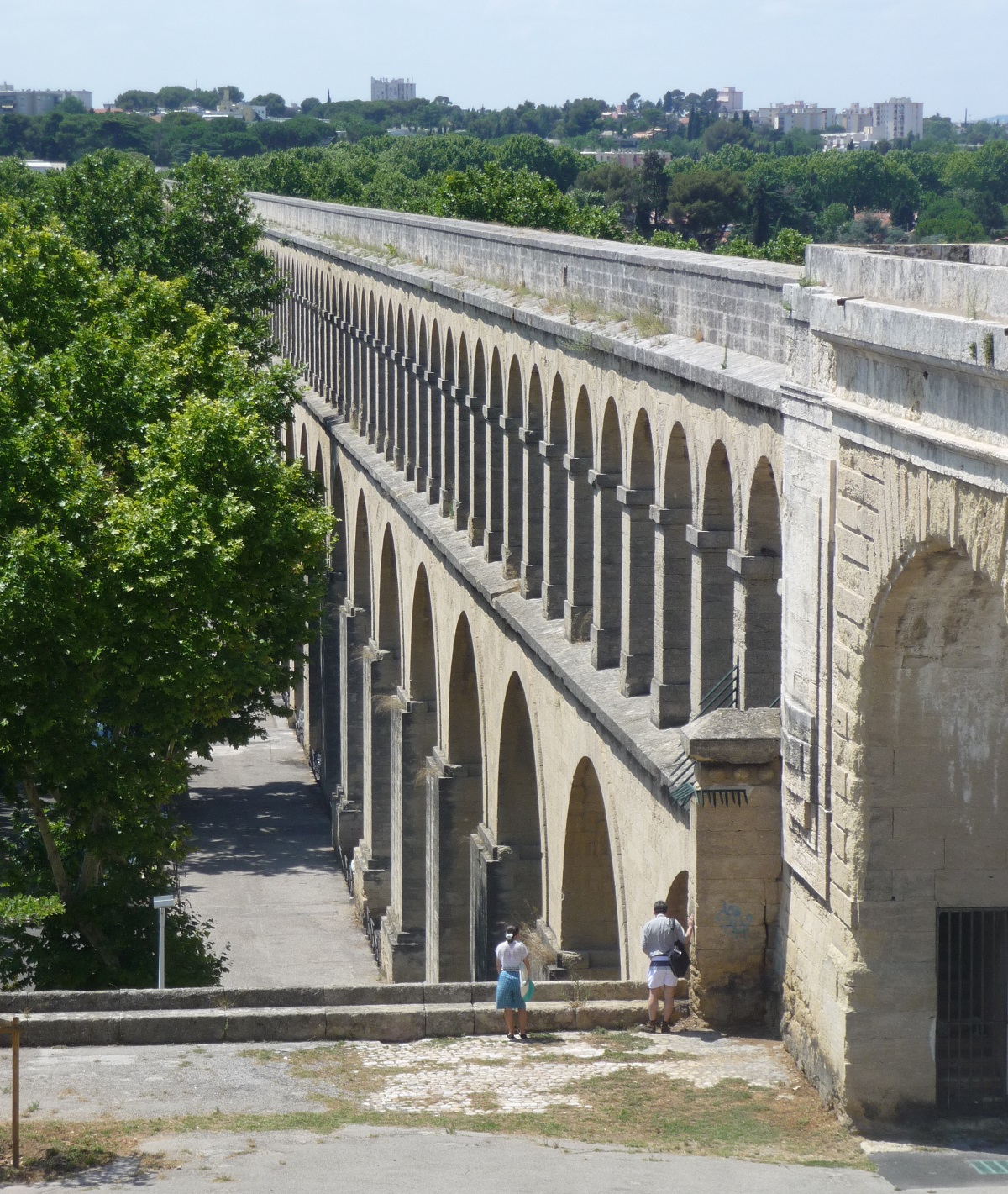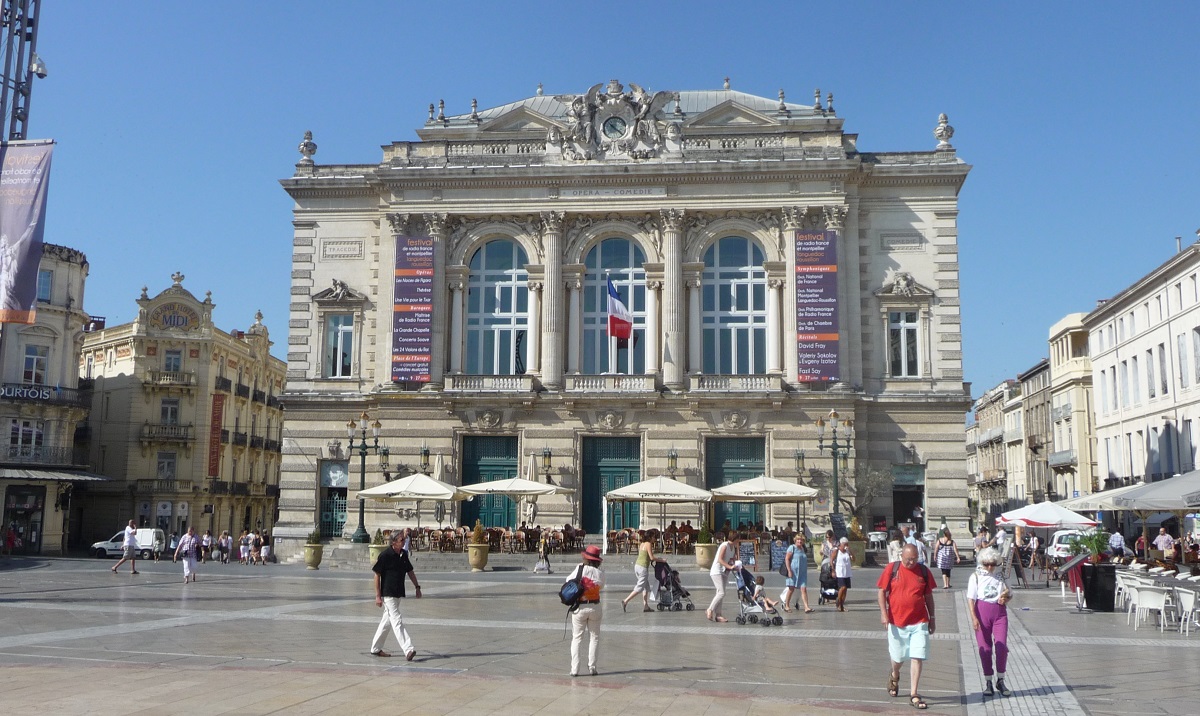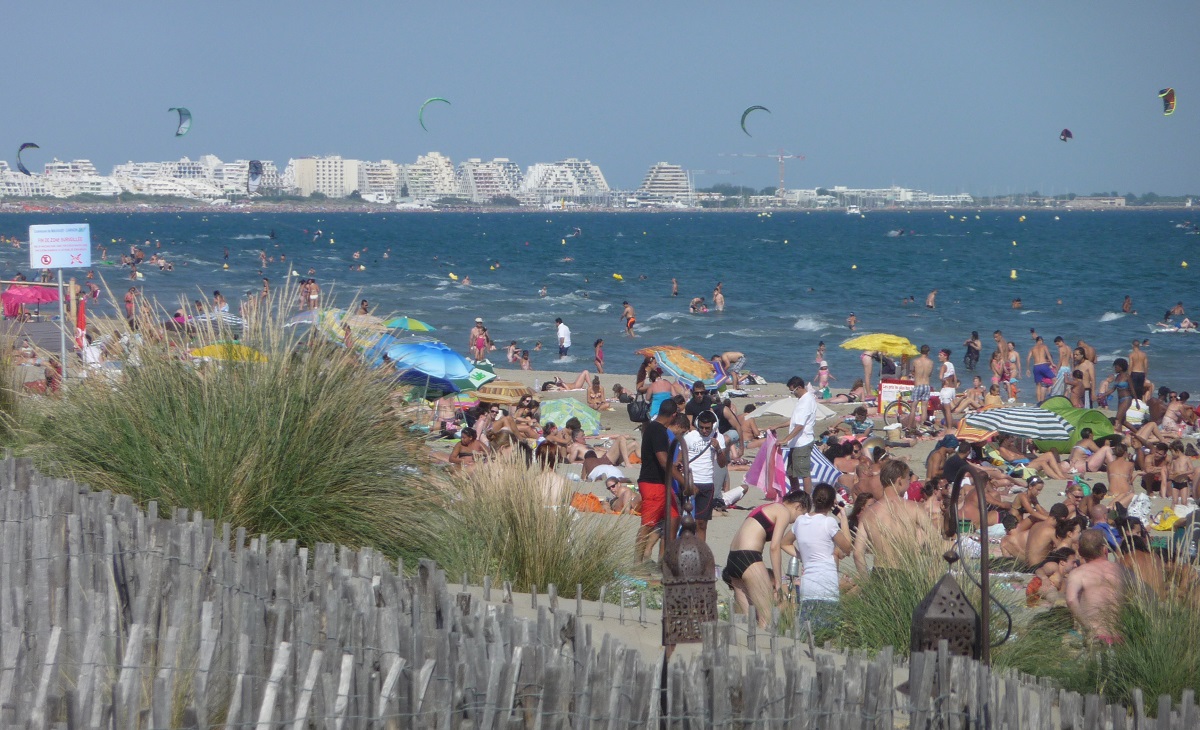Montpellier is one of the beautiful cities of southern France with its many nice churches, buildings, streets and squares. A city center lined with cafes, where the cuisine is tasty and where there are many and very varied things to look at in the mild Mediterranean climate.
The long and exciting history of the city has given it a number of interesting buildings and monuments, which are scattered in the city center and outside the heart of the picturesque old town. In many places, the oldest neighborhoods are like a maze, that you just have to explore.
Place de la Comédie is the center of modern and vibrant Montpellier. Here, inhabitants, trams, culture and shopping meet, and from here there is easy access to Place Royale du Peyrou, Montpellier’s Cathedral, the city’s two preserved medieval towers from the former fortifications and the Musée Fabre art museum, where works of great masters can be enjoyed.
The area around Place Royale du Peyrou is a special area. Here you will find elegant architecture and a beautiful city plan, where the square itself and the triumphal arch to the east are a few of the city’s gems. The equestrian statue of king Louis XIV is at the center of the square, and from here you can see the water tower Château d’Eau to the west.
A visit to Montpellier is an experience that combines the metropolis with the French Mediterranean atmosphere in a lovely climate. From the city center, there are just a few kilometers to the Mediterranean waves, many golf courses, varied and fascinating landscapes and other major cultural cities such as Nîmes, Arles and Avignon.

This is a beautiful park and promenade that lies like an impressive terrace above the city. Central to the square stands an equestrian statue of King Louis XIV, and to the west you can see the Château d’Eau.
Montpellier’s great triumphal arch, Porte du Peyrou, was erected in 1691 as a tribute to King Louis XIV. The Arc de Triomphe was constructed where one of the city gates once stood.

This is Montpellier’s mighty cathedral, built from 1364. Inside you can see stained glass windows from the 19th century and a masterpiece by Sébastian Bourbon from 1621.

Place de la Comédie is the central square and most popular meeting place in Montpellier. It was laid out in 1755 and there are fine buildings around it. You can also see the Three Graces/Trois Grâces fountain on the square.
Musée Fabre is a large art museum that houses one of France’s finest art collections. Here are many paintings from the 1400-1700s by i.a. Peter Paul Rubens and Pieter Brueghel the Younger.

This is an aqueduct built as part of the water pipeline that supplied the water tower at Place Royale du Peyrou with water from the Saint-Clément spring.
Montpellier’s Botanical Garden was founded in 1593 and it is the oldest in France and among the oldest in Europe. It offers many large and beautiful plants, trees and greenhouses that have inspired other gardens around the world.

This is an old pharmacy and a beautiful church. The on-site museum consists of two rooms displaying 18th-century and 19th-century pharmacies.
This museum is housed in the now historic church, Notre Dame de Table, and you can see an exciting exhibition about the city’s development from its founding to today at the museum.

The National Opera is Montpellier’s old opera building from 1888. The building was built in richly ornamented Italian style with a beautiful decor.

The Tour de la Babote is one of the two preserved towers from the city wall that enclosed Montpellier with walls and 25 towers in the Middle Ages. The city wall was built in the 12th century.
The esplanade park, together with the former military area Champ de Mars, is a favorite place to stroll in the city. Here are many trees that form a lovely oasis in the heart of Montpellier.

The Antigone district was developed in the 1980s by Spanish architect Ricardo Bofill. Streets, squares, activities, transport, etc. were created with the idea of creating a modern neighborhood in Montpellier just a few minutes walk from the old town center.

The city of Carnon is built on the strip of land between the lakes of Montpellier and the Mediterranean. Here are lovely beaches, and with tram and shuttle bus you can, as in only a few big cities, swim in the sea shortly after leaving the city center.
Piscine Castle is a beautiful residence that was built in the 18th century as a secluded place for the wealthy. In those days, the castle was far from the bustle of the city in the center of Montpellier, which has changed over the centuries.

Arles is an ancient city where you can see a number of preserved ruins from Roman times. These are, for example, the Arena / Arènes d’Arles and the Antique Teater / Theater Antique, but here are also many other things to see and do.
The old center of the beautiful city of Bézier is located high above the Orb River and the Canal du Midi. On a trip to the city you should explore along the river and in the narrow streets and alleys of the old town.

The Pont du Gard is an impressive Roman aqueduct that spans the river Gard well preserved. The building dates from the first century AD and is part of a 50 km/31 mi long water main from springs at Uzés to the town of Nìmes.
The city of Nîmes is one of the many lovely places in the south of France. The historical monuments in the city center are many and it is one of the places where the highest number of preserved Roman remains can be seen. The city’s ancient amphitheater and the Maison Carrée temple are the most famous sights.
Route de Carnon, Lattes
carrefour.fr
Allée Jules Milhau
galerieslafayette.com
Place du Polygone
polygone.com
Rue Foch, Rue St-Guilhem, Rue de la Loge, Grand’Rue Jean Moulin, Rue des Etuves, Place de la Comédie, Rue de l’Aiguillerie
Galilee Planéarium
Odysseum, Allée Ulysse
planetarium-galilee.com
Mare Nostrum
Odysseum, Allée Ulysse
aquariummarenostrum.fr
Montpellier Lunaret Zoo
50 Avenue Agropolis
zoo.montpellier.fr
Serre Amazonienne
50 Agropolis Avenue
zoo.montpellier.fr
Plages du Carnon
Carnon
In the late 900s, only a few people lived in the area between ancient Via Domitia and the Mosson area. It was during this time that Knight Guilhem was entrusted with the present area around Montpellier in recognition of his loyalty and general efforts to the regent.
Over the following decades, the Guilhem family built a smaller dwelling, and they built, among other things, a fortress and a church.
Guilhem’s ambitious plan for the city attracted people, and the city grew over the years in both population and prosperity.
The first thoughts of independence for the city spread in Montpellier around 1100, but the thoughts came to an abrupt end when Count Guilhem IV in 1143 stopped a revolt from Montpellier’s knights. Guilhem also had Pope Alexander III’s support for this use of power.
The events were the starting point for renewed economic growth in the city, and foreign traders settled in increasing numbers here. Montpellier, among other things, exported textiles to large parts of the Mediterranean.
With the financial success of the merchants, the demands for increased freedom and rights increased. They got that in 1204 after a marriage between Aragon’s Pedro II and Marie of Montpellier. Pedro II received Montpellier as a dowry.
The wedding ended the Guilhem family’s dominance in Montpellier and a new and very Republican form of government was established. The city gained significantly more rights, which meant, for example, that the city itself could elect twelve reigning consuls each year.
New and expanded city walls were also constructed so that the entire city could be assembled within the same area. The construction gave Montpellier’s old town the egg shape that can be recognized on map today. Back then, there were both walls and defense towers around the city.
Montpellier’s trade flourished, and not least spices brought prosperity. For these goods, the city was the market place for the entire French kingdom.
As a trading town, Montpellier introduced a new currency, and culturally and intellectually, the city developed tremendously with, among other things, several new institutions and a population that numbered about 40,000 people before the plague.
In 1180, Guilhem VIII of Montpellier had allowed everyone to teach medicine, and it marked the beginning of a great recovery in knowledge that has ever benefited the city.
Around 1220, Montpellier’s medical and legal faculties were established by Cardinal Konrad von Urach, and with this further build-up in the field of knowledge, prosperity continued to rise, and the city eventually became particularly interesting for the region’s rulers to control.
King Philippe le Bel bought the Montpellier area in 1293 by the Bishop of Maguelone, and he then established a number of regional administrative institutions in the city, and the city’s prosperity continued. Formally, however, the city and area were still under the crown of Aragon.
It didn’t take many years before the plague ravaged the area. It happened in the mid-1300s, and King Aragon of Jaime III of Mallorca sold the city and area to France’s King Philippe VI for 120,000 gold crowns.
France’s takeover of Montpellier marked the beginning of an almost uninterrupted 200-year decline in the city, which had hitherto been one of the absolute leading French cities.
However, there were also some bright spots for the city. Religiously, Pope Urban VIII gave the city a monastery dedicated to St. Peter in the 1300s. The monastery became significant and it ended in 1536 when the diocese seat was moved from Maguelone to Montpellier. On that occasion the church of the monastery was made a new cathedral.
Economically, there had also been bright spots; not least when Jacques Cœur came to town in 1432. He was a merchant, and during his time some flourishing was to be traced, but partly the power of the merchants in favor of office and legal scholars declined over the decades, and partly in the end of the century Marseille took over the role of the region’s economic center.
The Reformation rippled through Europe in the 16th century, and in Montpellier many of the citizens became Protestant. In this way, the city became a religious stronghold in opposition to Catholic France led by the French kings.
There was growing unrest between Catholics and Protestants in several parts of the country, and in Montpellier it ended with a siege over two months by King Louis XIII’s troops. The siege ended with the king’s victory, and after the victory the king let the great citadel of the city erect. This was done to ensure military control of the previously unruly city.
With the active counter-reform came new thoughts and thus the renewal of the once run-down city. Modern planning came into being and, among other things, Promenade du Peyrou was built. The city’s many elegant private mansions also shot up in the city, which in this time seriously cast off the Middle Ages. Montpellier had also achieved the status of Languedoc’s capital.
The economy flourished again and a growing production of textiles, leather, agricultural products and wine significantly increased the city’s revenue. In 1764, the aqueduct for the city center was erected. It brought water to Montpellier, which was a necessity for the city’s further development and modernization.
Railways were built in the 19th century, and the economy continued its positive development with some industrialization alongside large agricultural production. The upheaval lasted until the crisis in wine production, culminating in 1907. On that occasion, about 500,000 wine farmers demonstrated in the city’s streets.
Production progressed after some time, and today’s Montpellier took its final shape with the construction of central squares such as Comédie and many of the city’s new neighborhoods and green spaces.
In the 1960s, the city’s population rose sharply in connection with the resettlement of Frenchmen who, after Algeria’s independence, moved back to France.
In recent decades there has again been a great development in Montpellier. Among the biggest projects are the city’s modern tram network, Corum and the large city of Antigone. Antigone has significantly increased the city center, and the neighborhood has extended the city toward the river.
Overview of Montpellier
Montpellier is one of the beautiful cities of southern France with its many nice churches, buildings, streets and squares. A city center lined with cafes, where the cuisine is tasty and where there are many and very varied things to look at in the mild Mediterranean climate.
The long and exciting history of the city has given it a number of interesting buildings and monuments, which are scattered in the city center and outside the heart of the picturesque old town. In many places, the oldest neighborhoods are like a maze, that you just have to explore.
About the upcoming Montpellier travel guide
About the travel guide
The Montpellier travel guide gives you an overview of the sights and activities of the French city. Read about top sights and other sights, and get a tour guide with tour suggestions and detailed descriptions of all the city’s most important churches, monuments, mansions, museums, etc.
Montpellier is waiting for you, and at vamados.com you can also find cheap flights and great deals on hotels for your trip. You just select your travel dates and then you get flight and accommodation suggestions in and around the city.
Read more about Montpellier and France
Buy the travel guide
Click the “Add to Cart” button to purchase the travel guide. After that you will come to the payment, where you enter the purchase and payment information. Upon payment of the travel guide, you will immediately receive a receipt with a link to download your purchase. You can download the travel guide immediately or use the download link in the email later.
Use the travel guide
When you buy the travel guide to Montpellier you get the book online so you can have it on your phone, tablet or computer – and of course you can choose to print it. Use the maps and tour suggestions and you will have a good and content-rich journey.
Place Royale du Peyrou • Musée Fabre • Cathedral • Carnon Beaches
Overview of Montpellier
Montpellier is one of the beautiful cities of southern France with its many nice churches, buildings, streets and squares. A city center lined with cafes, where the cuisine is tasty and where there are many and very varied things to look at in the mild Mediterranean climate.
The long and exciting history of the city has given it a number of interesting buildings and monuments, which are scattered in the city center and outside the heart of the picturesque old town. In many places, the oldest neighborhoods are like a maze, that you just have to explore.
About the upcoming Montpellier travel guide
About the travel guide
The Montpellier travel guide gives you an overview of the sights and activities of the French city. Read about top sights and other sights, and get a tour guide with tour suggestions and detailed descriptions of all the city’s most important churches, monuments, mansions, museums, etc.
Montpellier is waiting for you, and at vamados.com you can also find cheap flights and great deals on hotels for your trip. You just select your travel dates and then you get flight and accommodation suggestions in and around the city.
Read more about Montpellier and France
Buy the travel guide
Click the “Add to Cart” button to purchase the travel guide. After that you will come to the payment, where you enter the purchase and payment information. Upon payment of the travel guide, you will immediately receive a receipt with a link to download your purchase. You can download the travel guide immediately or use the download link in the email later.
Use the travel guide
When you buy the travel guide to Montpellier you get the book online so you can have it on your phone, tablet or computer – and of course you can choose to print it. Use the maps and tour suggestions and you will have a good and content-rich journey.

This is an aqueduct built as part of the water pipeline that supplied the water tower at Place Royale du Peyrou with water from the Saint-Clément spring.
Montpellier’s Botanical Garden was founded in 1593 and it is the oldest in France and among the oldest in Europe. It offers many large and beautiful plants, trees and greenhouses that have inspired other gardens around the world.

This is an old pharmacy and a beautiful church. The on-site museum consists of two rooms displaying 18th-century and 19th-century pharmacies.
This museum is housed in the now historic church, Notre Dame de Table, and you can see an exciting exhibition about the city’s development from its founding to today at the museum.

The National Opera is Montpellier’s old opera building from 1888. The building was built in richly ornamented Italian style with a beautiful decor.

The Tour de la Babote is one of the two preserved towers from the city wall that enclosed Montpellier with walls and 25 towers in the Middle Ages. The city wall was built in the 12th century.
The esplanade park, together with the former military area Champ de Mars, is a favorite place to stroll in the city. Here are many trees that form a lovely oasis in the heart of Montpellier.

The Antigone district was developed in the 1980s by Spanish architect Ricardo Bofill. Streets, squares, activities, transport, etc. were created with the idea of creating a modern neighborhood in Montpellier just a few minutes walk from the old town center.
Similar to Montpellier Travel Guide